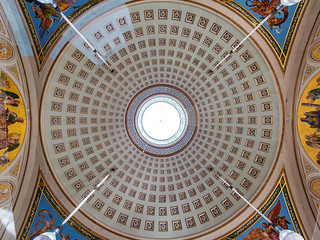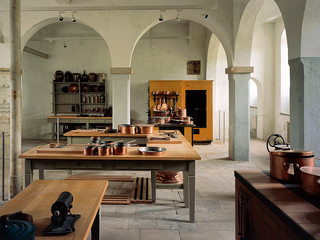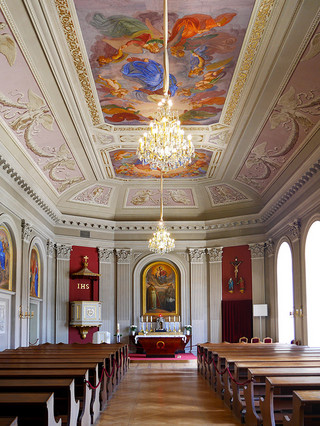»From pleasure palace to summer residence«
A little bit of royal everyday life: The permanent exhibition at the New Palace includes Dresden’s only domed Classicist building, the reconstructed royal court kitchen and the Catholic chapel. The permanent exhibition illustrates the history of the estate and courtly life at Pillnitz Palace & Park.
Domed Hall (ballroom and dining hall)
After, in 1818, the Renaissance Palace had been destroyed by fire, the New Palace was built in its place. Senior state master builder Christian Friedrich Schuricht (1753–1832) planned a building that ideally linked into the palace estate. Also, the Dining Hall which was inaugurated in 1823 is to be found in the New Palace.
As Dresden’s only domed Classicist building, it has mainly representative character for its wide access to the pleasure garden.
Six free-standing Corinthian columns on each side of the square room support the suspended coffered dome with its open lantern. Carl Christian Vogel von Vogelstein painted murals with his views he had gathered in Rome influenced by the Nazarene movement.
Royal Court Kitchen
There had to be a kitchen in the New Palace completed in 1830. The Royal Court Kitchen had to cater for the royal family and its entourage of all the servants – at least 70 people – every day. It was strictly organized in accordance with the respective works to be done:
»Tasting Side«, »Frying Side«, »Baking Side«, »Stuffing Chamber«, »Meat Vault«, »Pantry«, »Ice Pit« and »Kitchen Scribes’ Office«. In each kitchen area, there was a responsible »chef de cuisine«, »baking chef« and »frying chef« with further personnel. A total of 27 servants working in the Court Kitchen were all coordinated by the head chef and his scribe’s office.
Much of the kitchen inventory had been lost in the fire of the old Renaissance castle in 1818, so that the Royal Kitchen had to be newly equipped. After the abdication of the royals in 1918, the kitchen was used for other purposes. The room structure and almost all of the inventory had been devastated or gone missing at the beginning of reconstruction in 2000. Written sources, pictures and architectural-archaeological traces helped in restoring it. Today’s furniture and parts of the cooking appliances are historically true replicas, and pieces of equipment were purchased. The kitchen copper on display originates from the Saxon court. Since 2003, the Royal Court Kitchen has been shining in its new »old« splendor again.
The Catholic Chapel
By building the New Palace, senior state master builder Christian Friedrich Schuricht closed off the Pillnitz Palace estate to the east. In the north wing of the Palace, a new single-nave Catholic court chapel was installed between 1823 and 1829. Despite its plain outer appearance, this court chapel and its richly decorated interior and the murals by Carl Christian Vogel von Vogelstein (1788–1868) demonstrate the representative claim of royal family. The Mariological cycle al fresco created by painter Carl Christian Vogel von Vogelstein jointly with students of the Dresden Academy of Fine Arts, has adorned the Catholic Chapel since 1829. On 16 June 1830, the chapel was consecrated by Bishop Mauermann dedicating it to Holy Trinity. It is still being used today by the Catholic Church.
Contact
Pillnitz Palace and Park
August-Böckstiegel-Straße 2 | 01326 Dresden
Property of State Palaces, Castles and Gardens of Saxony, non profit
+49 (0) 351 2613-260
pillnitz@schloesserland-sachsen.de



